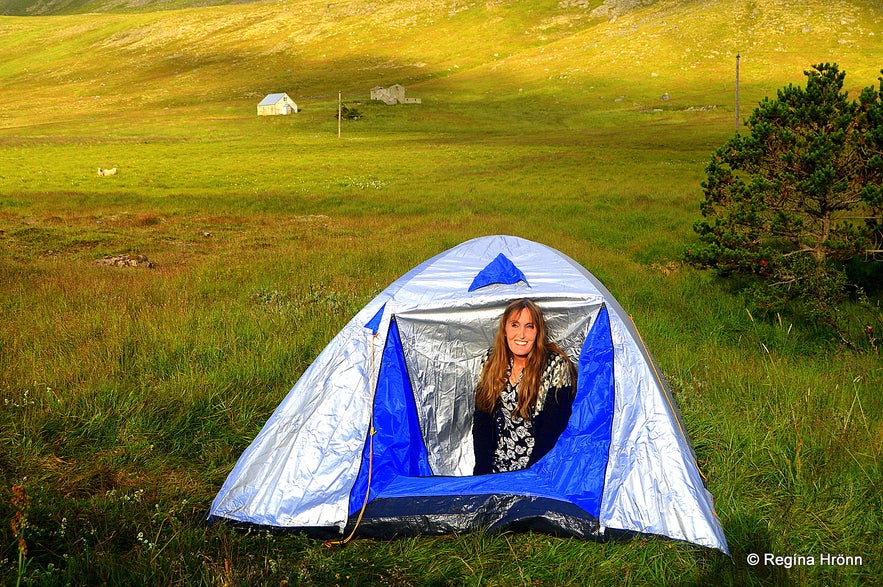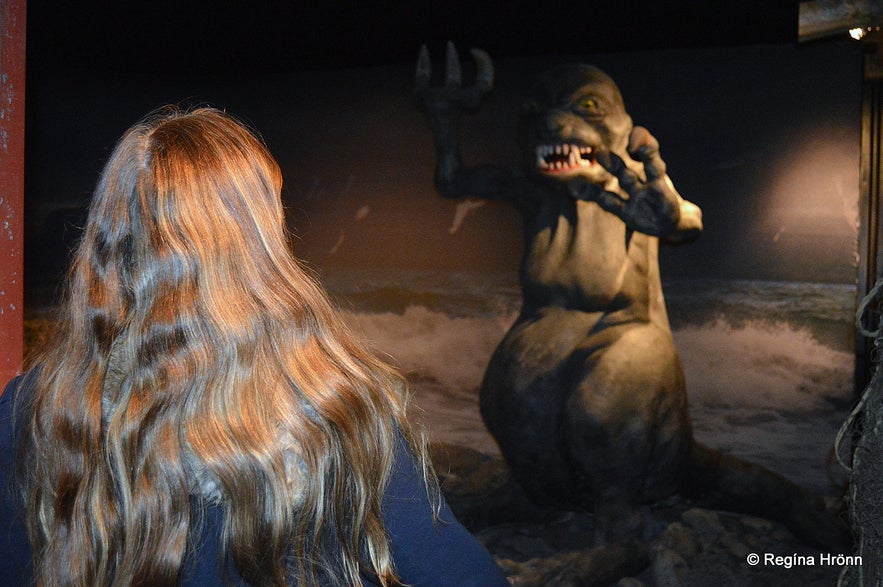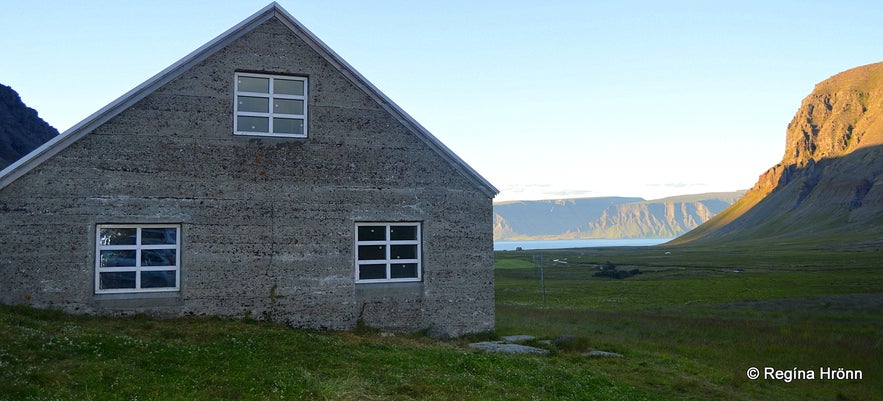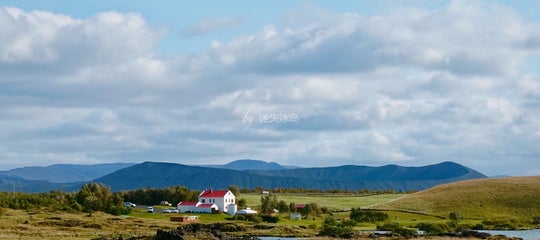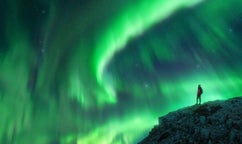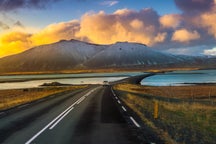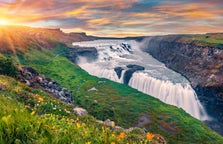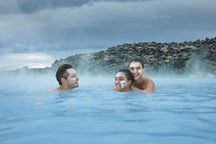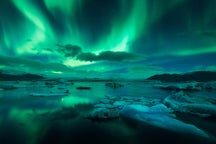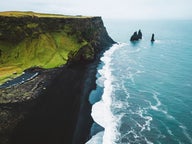
On one of my visits to the Westfjords of Iceland, I visited Arnarfjörður, the second-longest fjord in the Westfjords. It is believed that nowhere else in Iceland have there been more sightings of sea monsters than in this beautiful fjord in Iceland's mysterious Westfjords.
We Icelanders have known about the sea monsters ever since the Vikings settled Iceland around 874. Throughout the centuries there have been over 4,000 recorded sightings of sea monsters and lake monsters all around Iceland!
Top photo: Admiring the view
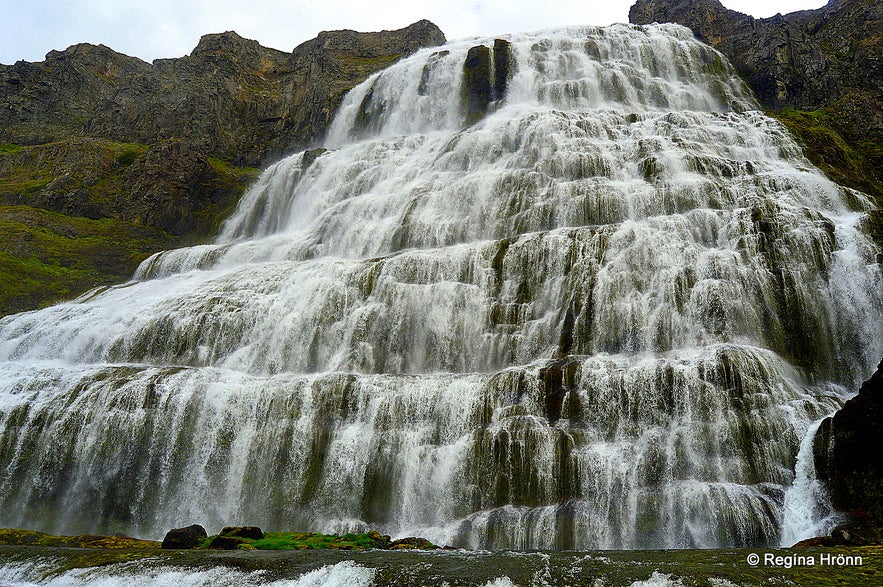
Dynjandi waterfall
Many of the sea monsters have been seen in Arnarfjörður and the Westfjords. There have been some 180 recorded sightings of sea monsters in Arnarfjörður fjord alone!
Arnarfjörður is a beautiful fjord, approx. 38 km long and approx. 9 km at its widest.
There are many beautiful inlets in Arnarfjörður fjord and the Jewel of the Westfjords, Dynjandi waterfall is to be found in Dynjandisvogur cove in this lovely, but monster-filled, fjord.
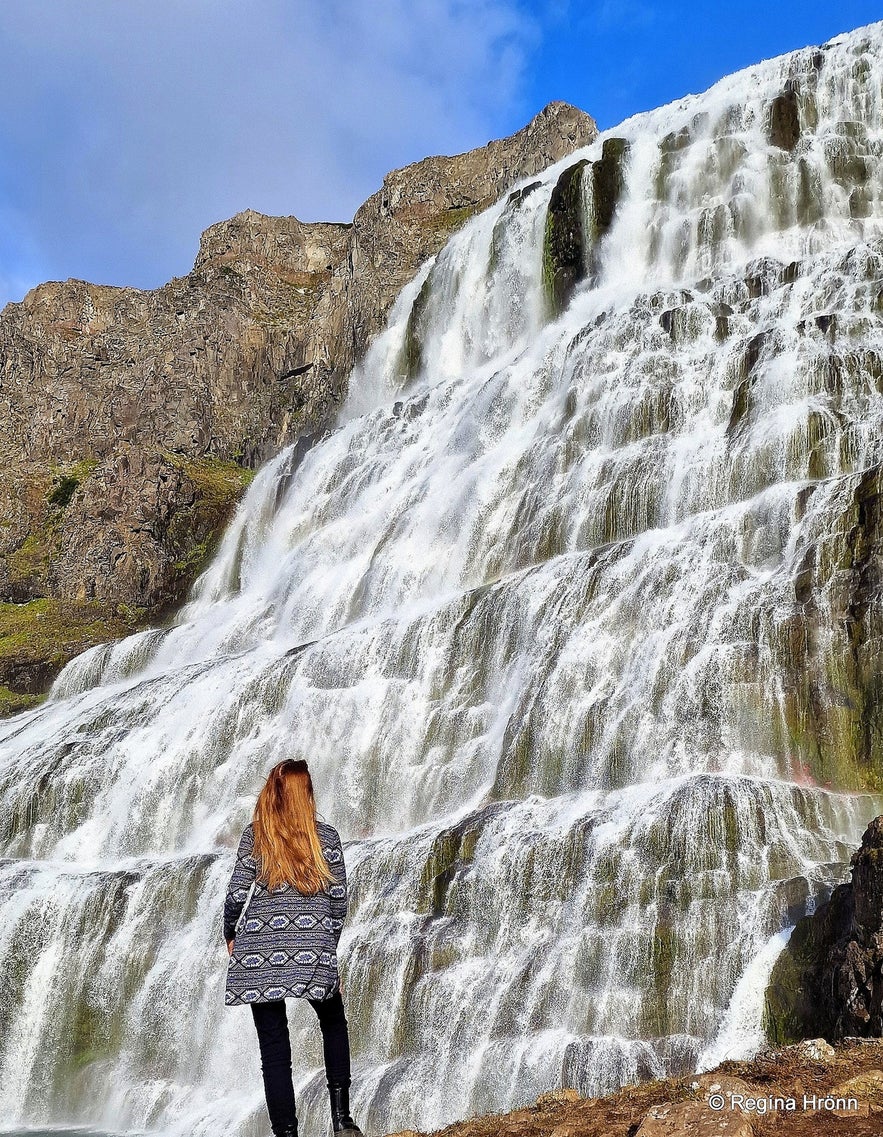 Admiring Dynjandi waterfall up close
Admiring Dynjandi waterfall up close
Sea monster stories have become a bit of a taboo, but as we all know then there are endless species of fish in the ocean, both large and small - so why not something that looks like sea monsters?
I, for sure, believe that they exist, I don't know what they are, but there are for sure more creatures lurking in the sea than we know of!
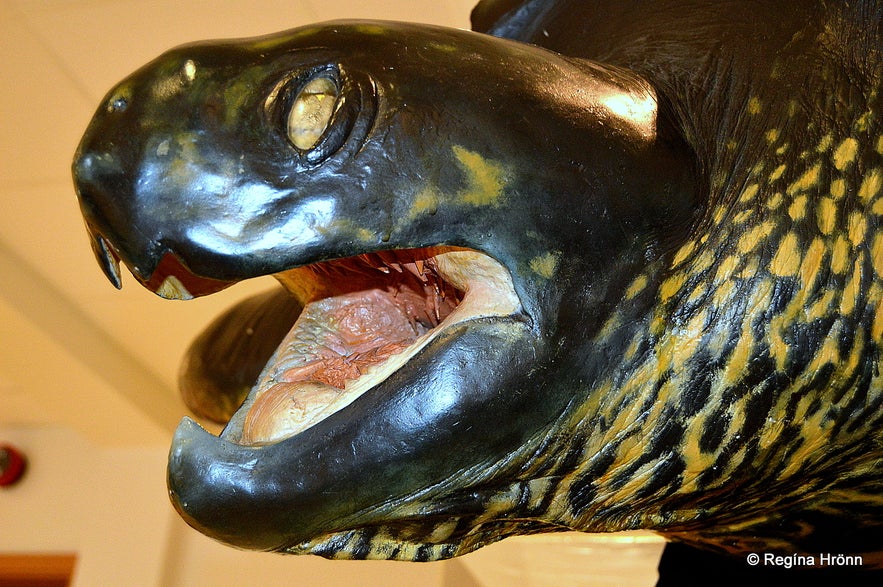
A huge sea turtle in Hólmavík
In Hólmavík on the east side of the Westfjords, a huge sea turtle was found - the biggest species of sea turtle in the world! How did such a big sea turtle come to be found in the cold sea around Iceland?
If it had been found in the olden times it would for sure have been called a sea monster.
On one of my travels to the Westfjords, I spent 9 days exploring this quiet area of Iceland (the following year I spent 8 days in the Westfjords). I slept in hotels and with relatives, but for one night I slept in a tent in a remote valley in Arnarfjörður.

The church, the home, and the art museum of Samúel Jónsson
I was coming from Patreksfjörður village and took road 63 towards Bíldudalur village. I then turned on Ketildalavegur road no. 619 and drove to the end of it (25 km) as I knew that there I would find a camping place and interesting things to see.
Road 619 is a very bumpy gravel road, so it took me a longer time than I had planned to reach my destination.
Plus I was always stopping to have a look at this and that and to take photos, so it takes me a while to arrive at my destination.
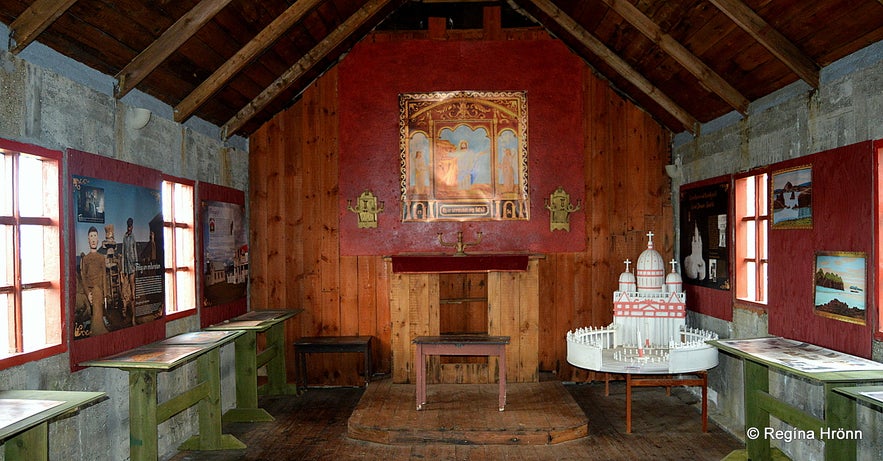
Inside the church of Samúel Jónsson
Then an encounter with a fellow Icelander made me change my plans. I had already started putting up my tent on the campsite by the sea in Selárdalur valley but changed my mind when an Icelandic woman scolded me and told me - in English - that I could not camp anywhere I liked!
The campsite is in fact by the Art Museum of Samúel Jónsson at Brautarholt, but Samúel - "Sambi" (1884-1969) was a well-known folk artist, who was often called "Listamaðurinn með barnshjartað" or the Artist with the naive heart.
He built a church on his land, even though another church, Selárdalskirkja, is only 1 km away.
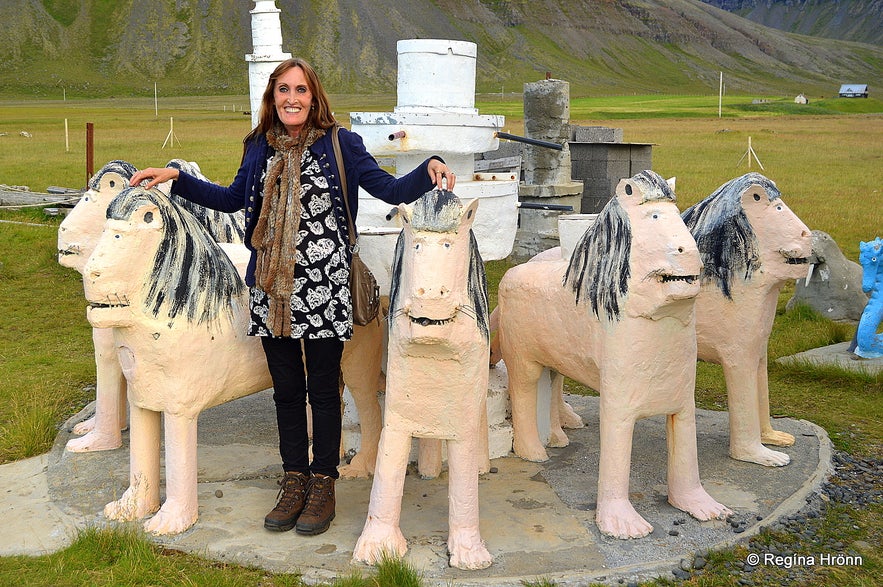
At the art museum of Samúel Jónsson - Ljónagosbrunnurinn
Samúel had painted an altarpiece to donate to the existing church on its 100th anniversary, but it wasn't needed, as the church already owned a valuable old altarpiece. So Samúel built his own church around his altarpiece. This extraordinary man also painted a myriad of paintings.
Outside, you can see a likeness of the famous fountain (Patio de Los Leones) in the Alhambra palace in Granada Spain, amongst many other of his artworks. Like Leif the Lucky looking at America (Vínland) and a boy feeding sea cows.
For 20 years now the Association for the Restoration of the Art Museum of Samúel Jónsson has maintained the artwork and saved it from destruction. When you visit it please leave a donation in the collection box, it means a lot for the upkeep of this quaint little museum.
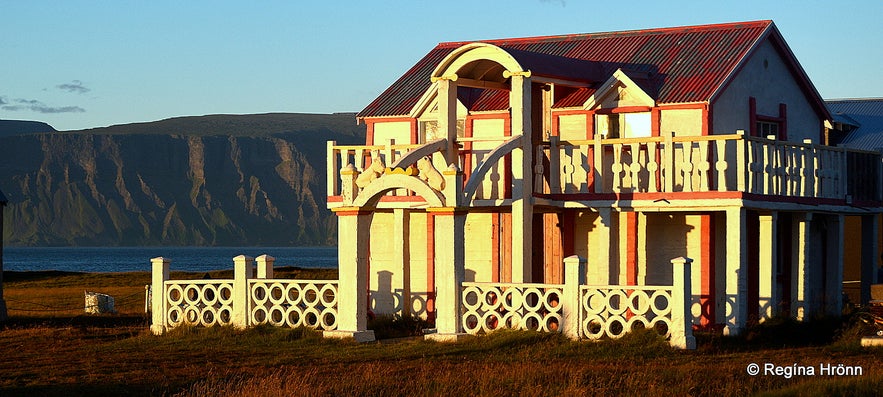
The art museum of Samúel Jónsson in the evening sun
In 2020 a café and a gift shop were opened by the museum, which are open in the summer months, i.e. from the beginning of June until the end of August.
Now back to my camping predicament - I tried to explain to my countrywoman - in Icelandic, which is our common language - that this was indeed a marked campsite, but she kept on telling me in English that I could not camp just anywhere I wanted.
It wasn't until I showed her that this was, in fact, a legitimate campsite that she understood that I was Icelandic and knew that I could not camp outside of the campsites in Iceland. But this put me off camping here.
Camping in Selárdalur
We have recently been seeing tourists camping everywhere, which is such a nuisance, so I understand why she felt the need to tell me to go to a campsite, even though I was at a campsite.
Check out the article Camping in Iceland - All you need to know.
And, the article the Perfect camping tour in Iceland for information on the rules for camping in Iceland.
I moved my tent further up into Selárdalur valley. In Iceland, it is only allowed to camp on campsites unless there is a dire need for camping for one night - and then you must get permission from the landowner first.
Uppsalir in Selárdalur
I was a bit reluctant to put my tent up in the valley, but as it was getting very late and there was nobody in this remote valley - and the closest farm, Uppsalir, was abandoned. I decided that my situation was indeed a dire need and camped here for one night.
I didn't sleep well though and thought that somebody would show up and scold me and tell me to leave.
Sure enough, I was awakened a couple of times during the night by heavy tramping by the tent. I woke up with such heart palpitations and didn't dare to look out - but then I heard bleating and realized that the local sheep had come to check out my tent.
Sheep in Selárdalur - we had camped on their turf and they were not happy about that
When I left the next morning the sheep were standing by the car looking at me accusingly as this spot was seemingly their night-lodging in the valley!
Don't follow my example, this was a one-off and no sleep to be had. If you are going to camp in this area opt for the campsite at Bíldudalur village, which is renowned for its calm weather. You could then pay a visit to the Sea Monster Museum in the morning.
This was the night before I visited the Sea Monster Museum, so I didn't know that sea monsters had been seen in this exact area in Arnarfjörður - Iceland's most notorious sea monster fjord! Live and learn!
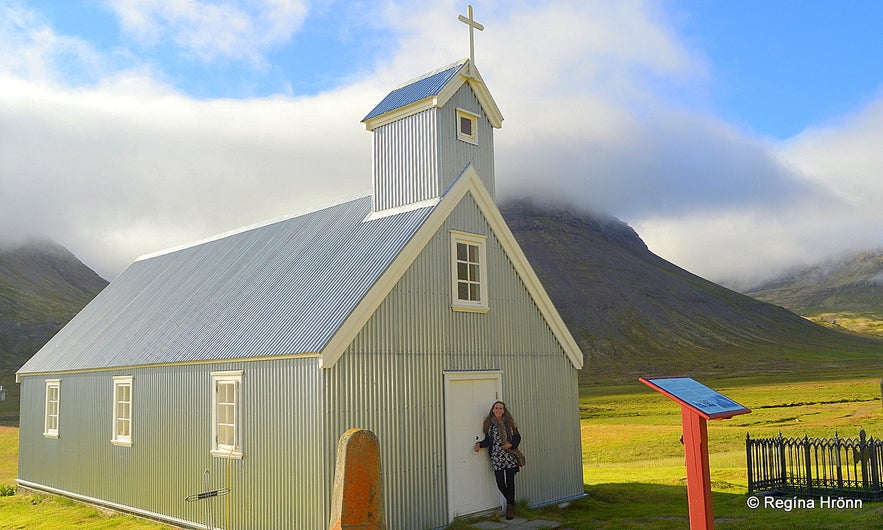
Selárdalskirkja church in Selárdalur
There is a sea monster tale from Selárdalur: "A man named Árni went from Selárdalur to hunt foxes at a cliff called Gammur. While he was waiting for the fox to appear a creature appeared from the sea, as tall as a man, but with thick legs with claws. It moved slowly towards Árni.
Árni got frightened and shot at the creature, which hurried back into the sea and disappeared" (retold from an account at Skrímslasetrið - Sea Monster Museum).
And here I was camping in this area, totally oblivious to the sea monsters! I am glad that I didn't choose to camp by the sea in Arnarfjörður as I had planned - as I would not have wanted to wake up to a sea creature crawling into my tent!
Bíldudalur and the Sea Monster Museum
At the Sea Monster Museum
Bíldudalur is a small village in Arnarfjörður with a population of around 238 people. This lovely little village has been called "The Good Weather Capital of the Westfjords" as the mountains shelter the village from the wind. The 2 days I visited Bíldudalur the weather was completely still and lovely.
In the old dilapidated building of the "Matvælaiðjan" food processing, especially known for their Bíldudalur green beans, work started in 2007 on creating a sea monster museum with the help of many people, who had moved away from Arnarfjörður and wanted to do something for their old village.
The museum building was restored with many a helping hand, which shows the solidarity of the people in Bíldudalur.
I visited the museum as I wanted to get to know more about the sea monsters in Iceland. I timidly walked down a spooky corridor only to be greeted by 2 ugly monsters, the Shore Laddie and the Sea Man!

Pretty Arnarfjörður
The Shore Laddie and the Sea Man have frequently been seen on the shore in Iceland! What are these creatures and why have they so often been seen on the shore in Iceland? The Shore Laddie is even the most commonly seen sea monster in Iceland!
Icelanders have through the ages believed in monsters, trolls, and elves - we have a myriad of such stories written f.ex. in Þjóðsögur Jóns Árnasonar - the Collection of Folklore of Jón Árnason, which I refer to a lot in my travel-blogs.
I am very interested in folklore and look for elf locations all over Iceland, which I have read about in this series of books.
But it is only after I visited the Icelandic Sea Monster Museum that I became interested in these scary creatures walking ashore from the cold sea surrounding Iceland.

Sea stacks in Arnarfjörður
At the museum, you can watch accounts on-screen from people who encountered sea monsters. And listen to stories on sightings and encounters with sea monsters.
Eiríkur Eiríksson told of a monster he had seen both at Sperðlahlíð and at Krosseyri. He claimed to have seen its excrement, which lay in three huge clumps and looked like chalk coloured mud covered in green slime!
The monsters seen around Iceland can be divided into 4 main monster categories - the Shore Laddie, the Sea Man, the Shell Monster, and the Sea Horse. What makes Arnarfjörður fjord stand out is that all of these monsters have been seen here in this fjord! And many other extremely large monsters and smaller ones.
So this beautiful, tranquil fjord in the Westfjords stands out as being the Sea Monster Fjord in Iceland. I shot this short video in Arnarfjörður during one of my visits to the Westfjords, just to show you how beautiful it is:
There is an account of the six-oared boat "Heppinn" or Lucky running aground on a Sea Horse in 1915 at the mouth of Arnarfjörður. Other sightings took place in 2000 and 2002, when the Icelandic fisherman, Sverrir Garðarsson, encountered this monster twice!
The monster raised up its long neck by Sverrir's boat and the monster hovered high above the wheelhouse of the boat, where Sverrir was standing!!
The recluse Gísli at Uppsalir
The former farm of Gísli at Uppsalir
I noticed the following advice at the interactive monster table at the museum from the recluse, Gísli at Uppsalir in Selárdalur valley, and what he had to say about meeting sea monsters:
"Mætirðu skrímsli mátti ei trega, maður þá vex þín neyð. Heilsaðu bara hæverkslega, haltu svo þína leið". It goes something like this, loosely translated: "If you meet a monster, don't be afraid, you will only be in a worse place by fearing the monster. Just great it politely and carry on walking"!
Gísli (1907-1986) obviously knew what he was talking about, having lived his life as a recluse in Uppsalir in the remote valley of Selárdalur. Which incidentally is the same place where I camped for one night.
Gísli Oktavíus Gíslason became nationally renowned when Árni Johnsen interviewed him back in 1977 and published it in Morgunblaðið - our morning paper.
And he became even better known when Ómar Ragnarsson visited him and he appeared on telly. Above you can watch the episode of Ómar Ragnarsson's Stiklur, when he visited Gísli at Uppsalir back in 1981. It is in Icelandic only though but gives you an idea of what the life of a recluse in a remote valley in the Westfjords of Iceland was like.
The video was shot by my brother-in-law, Páll Reynisson, who now runs the Wildlife Museum in Stokkseyri in South Iceland. I own the entire video series of Stiklur, but found this video on YouTube. I don't know if I have permission to repost it though as our state-run broadcasting company RÚV had the rights to it.
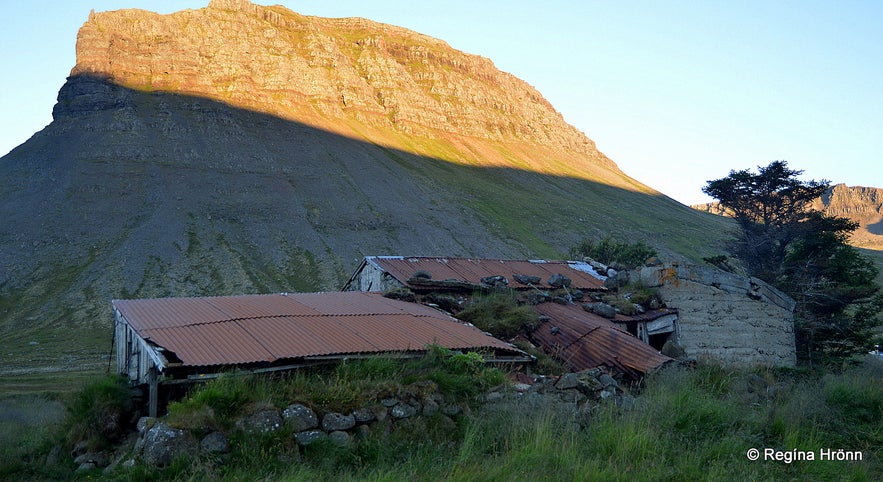
The turf sheep barn at Uppsalir
Gísli didn't interact with many people and we Icelanders cannot even understand what he was saying in the video. What a lonely life he must have lived.
These sea monster stories, which I have told you here, are only a few of thousands of stories on human encounters with sea monsters in Iceland. Maybe the sea monsters don't appear any longer - who knows - maybe they do, but I am pretty sure that you will have a different view on the existence of sea monsters when you leave the Westfjords.
The Icelandic state owns Uppsalir and I read in the newspaper that his house is being renovated by a group of people in Félag um safn Gísla á Uppsölum, and a museum with a café will be opened there in 2024 if all goes well. What a great idea :)
Hringsdalkumlið pagan graves
An information sign by Hringdalskumlið pagan graves
Driving on road 619 on the way to Selárdalur you might notice information signs and an archaeological excavation site. Here we find Hringdalskumlið pagan graves, which are believed to date back to the 10th century!
These pagan graves are very close to the sea and the sea is, unfortunately, eroding the graves. Thus a thigh bone of a man was discovered here back in 2006 and archaeologists were sent to Arnarfjörður for experimental digs.
They dug up 5 pagan graves and even a boat grave. The graves contained skeletons and grave goods; an axe, a Viking sword, a comb, a spearhead, and a boss (a knob on a shield).
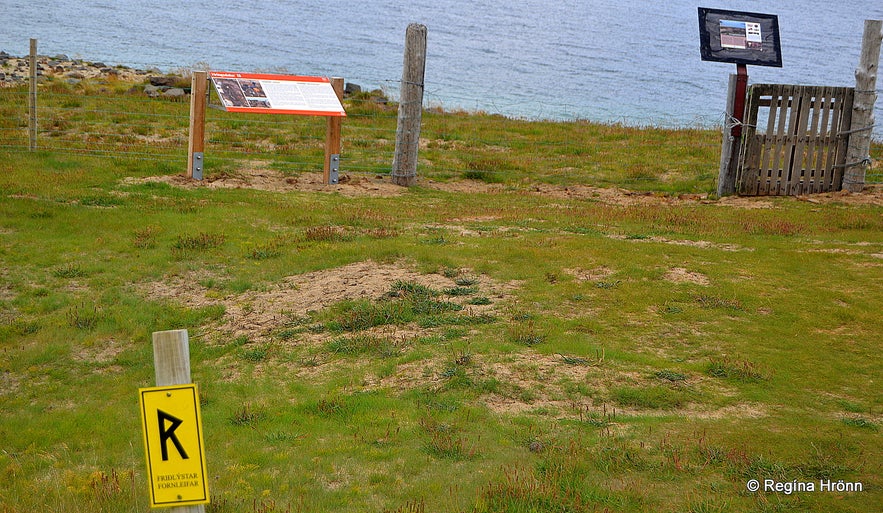
This yellow R "friðlýstar fornleifar" sign means that it is a protected archaeological site
This was indeed a pagan grave as in pagan times animals, grave goods, and sometimes boats were buried with their owner, which was not the case with Christian graves.
These pagan graves might have been the graves of one of the Viking settlers in this area, Hringur, who gave his name to Hringdsalur valley and thus the archaeological dig. He lost his life here and might have been buried in one of these graves, who knows?
According to Landnáma, Iceland's Book of Settlements, then many of the place names in Arnarfjörður derive from the settlers of this area. Arnarfjörður itself is named after the settler Örn and Geirþjófur Valþjófsson settled Geirþjófsdalur.
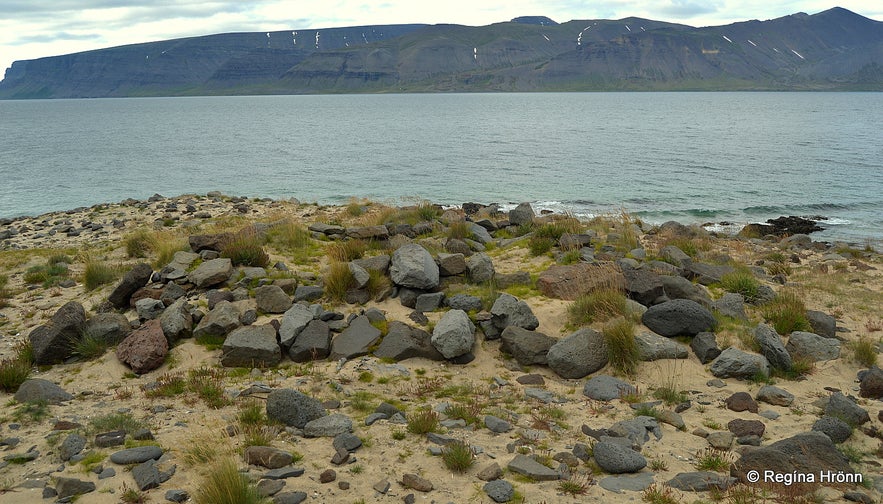
Hringsdalskumlið pagan graves
Tread lightly when you visit archaeological sites as they are delicate areas. Plastic and rocks have been used to cover up the burial mound and fingers crossed that the sea will not erode more of it.
If you want to read up on other archaeological excavations in Iceland then I have written a special travel-blog about that subject:
Viking burial mounds and archaeological excavations in Iceland
As you will notice then the sand is pink or yellow, which is characteristic of the Westfjords of Iceland and some of the Snæfellsnes peninsula beaches. Most beaches in Iceland are black lava sand beaches.
Driving further in Arnarfjörður

Reykjafjarðarlaug geothermal pool in Reykjarfjörður
Arnarfjörður fjord is very long with many smaller fjords and coves, and there is so much to see here.
The Arnarfjörður fjord system consists of: Dynjandisvogur, Borgarfjörður, Bíldudalsvogur, Fossfjörður, Reykjarfjörður, Trostansfjörður and Geirþjófsfjörður.
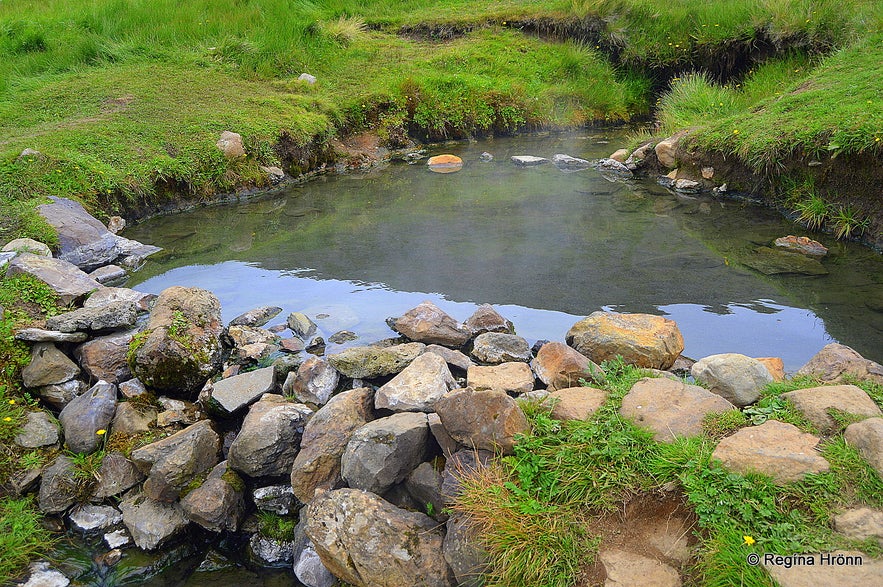
One of the hot pools of Reykjarfjörður
When I returned to Bíldudalur I drove further along road 63 and reached the hot pools of Reykjarfjörður, which are right by the road.
There you will find both the Reykjafjarðarlaug swimming pool and a warm creek in which you can bathe.
See also:
A selection of the hot pools I have visited on my travels in the Westfjords
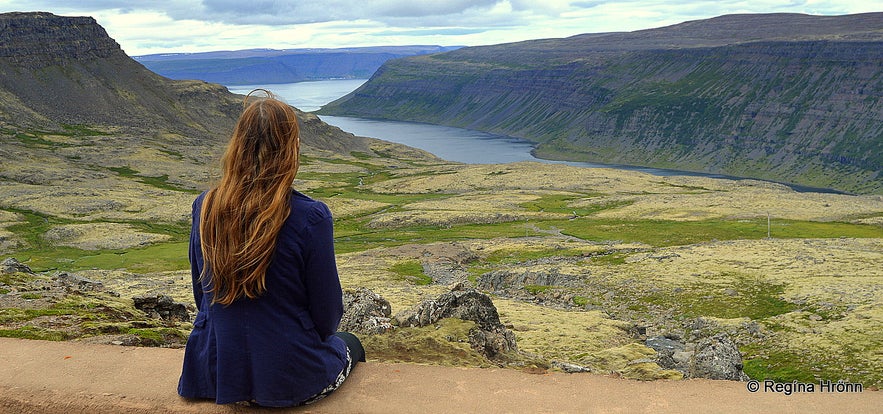
Admiring the view of the Arnarfjörður fjords from above
Road 63 then merges with road 60 as you pass the Dynjandisheiði heath (24 km long with the highest level being 500 metres). Dynjandisheiði heath is closed in the wintertime due to weather conditions and can be closed up to 5 months per year.
While driving on the bumpy russet road in the summertime you have a partial view of Trostansfjörður and the beautiful Geirþjófsfjörður fjords (see my first photo in this travel-blog). A new road has been built now (2024), so the conditions are different.
In this area the Viking Saga Gísla Saga Súrssonar took place and on the heath, you will find information signs about special events in this well-known Saga.

Dynjandisheiði heath
After passing Dynjandisheiði heath the road takes you down to Dynjandisvogur cove to the massive Dynjandi waterfall, the Jewel of the Westfjords.
On the heath, you will be driving on top of the river creating this beautiful waterfall. Dynjandi waterfall is my second favourite waterfall in Iceland, absolutely stunning!
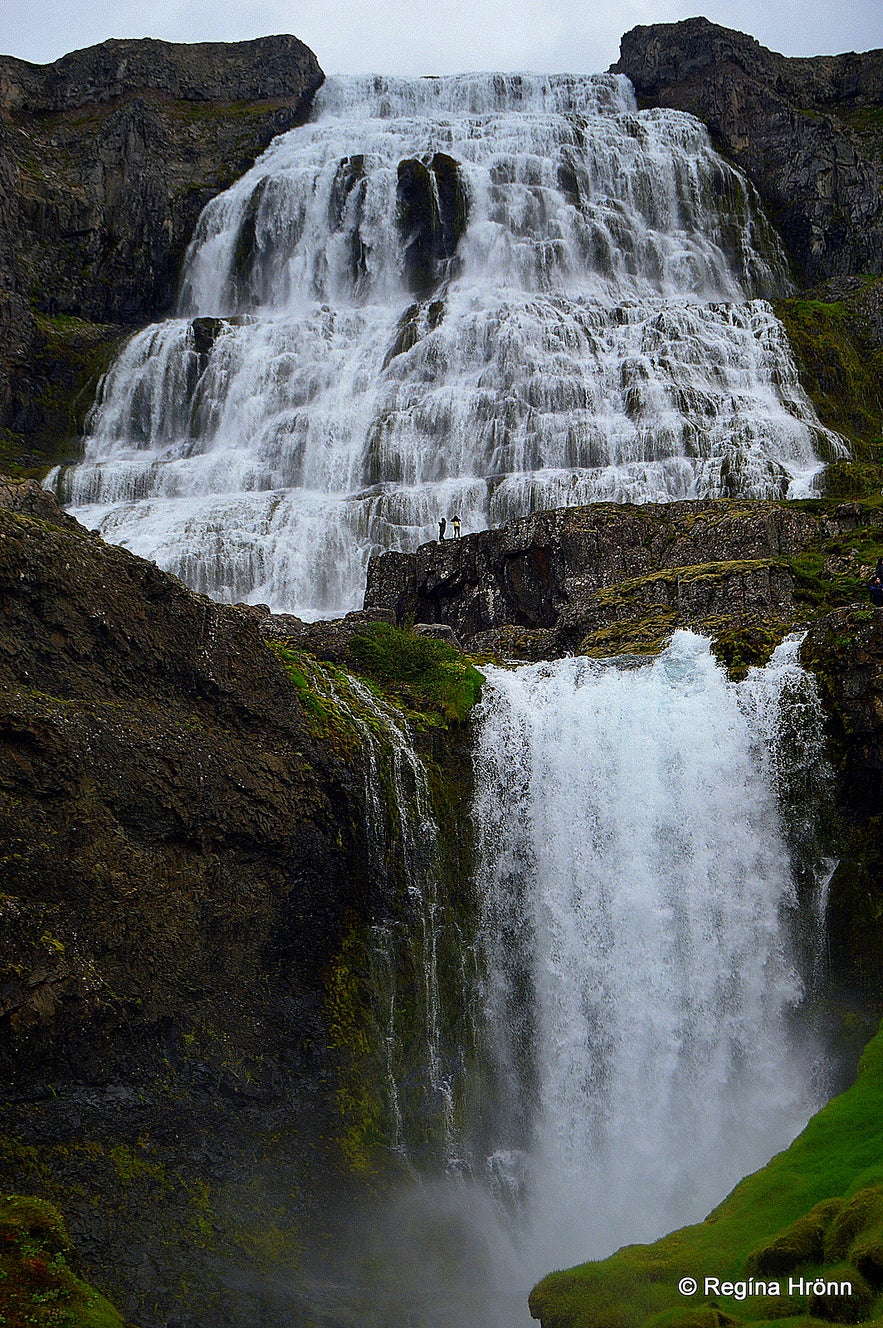
Dynjandi waterfall
Dynjandi cascades 99-100 metres in the shape of a bridal veil - on top it is 30 metres wide and 60 metres wide at the bottom. On the upwards hike to Dynjandi, you will find 6 other waterfalls, making it such a scenic route :)
See many more photos in my travel-blog the Magnificent Dynjandi Waterfall - the Jewel of the Westfjords of Iceland.
After visiting Dynjandi waterfall driving on road 60 you will see several other beautiful waterfalls.
You will also pass the Mjólkárvirkjun hydroelectric power plant in the Borgarfjörður part of Arnarfjörður, which generates electricity for the area.
Dýrafjarðargöng tunnel opened in the year 2020 from Arnarfjörður to the next fjord Dýrafjörður. 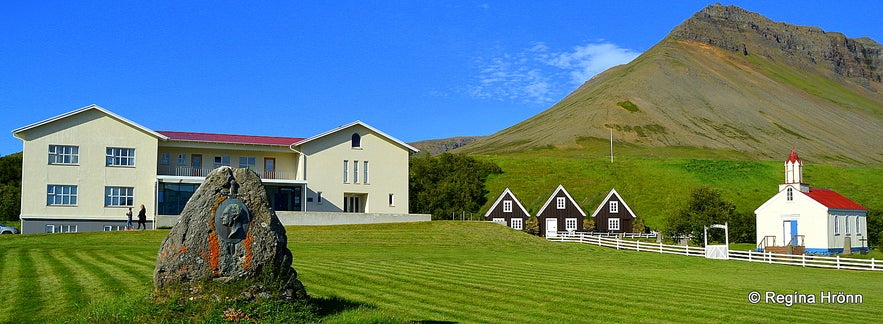
Hrafnseyri - the birthplace of Jón Sigurðsson
If you don't drive through the tunnel, the road will take you to Hrafnseyri, the birthplace of our national independence hero Jón Sigurðsson (1811-1879).
Jón was such an important man in Iceland's history that we celebrate our national day on the 17th of June, the birthdate of Jón Sigurðsson.
At Hranfseyri you will find a museum, a church, and a replica of the turf house (built in 1997) in which Jón lived. The turf house is a café that is lovely to visit. I have visited the museum on 3 occasions and recommend stopping at Hrafnseyri.
I love turf houses and have written a travel-blog with a list of all the turf houses I have visited in Iceland.

The turf house at Hrafnseyri
A small Viking longhouse was discovered in an archaeological excavation in 1977-1978 at Hrafnseyri and one of the biggest Viking longhouses in the Westfjords was discovered during an archaeological dig at Auðkúla only a km away from Hrafnseyri.
I visited the archaeological site of Auðkúla in the fall of 2024 and took a video of the longhouse.
The longhouse is 23 metres long and here some wealthy Vikings seem to have lived in the 9th or 10th century.
Five longhouses have been discovered in the Westfjords already and there are most likely many more, which are still undiscovered.
Remember to look back as there is a wonderful view of the Dynjandi waterfall from this side of the road. It is difficult to get a good enough photo of it though from the car window.

Dynjandi waterfall as seen from afar
From Hrafnseyri you can drive up to Hrafnseyrarheiði heath leading to Dýrafjörður and Þingeyri village.
Another beautiful part of Arnarfjörður leading to Dýrafjörður fjord is the drive on the most dangerous road construction in Iceland, Svalvogar and Kjaran's Avenue.
This is not even a marked road and is only open a couple of months a year.
Instead of driving up on Hrafnseyrarheiði heath, you carry on driving along the coastline. This is a road for 4x4 only and only if you have nerves of steel and come fully prepared.
Read my travel-blog about this scenic drive to see what I am talking about.
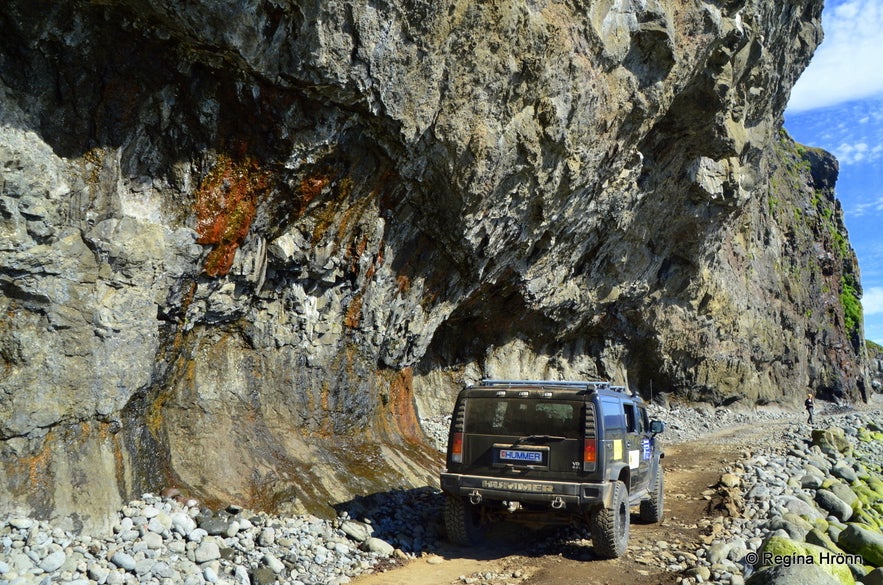
Driving on the road by Skútabjörg cliffs
My photos above and below are from the Arnarfjörður part of the drive, but on the Dýrafjörður part you will be driving on a tiny road carved into the steep mountainside and even the Road Administration of Iceland gave up on this project.
It is best to join a guided tour of this hazardous road with an experienced local driver:
Crown Jewel Jeep Tour - Kjaran's Avenue & Dynjandi (which I joined).

Driving by Skútabjörg cliffs
To reach the Westfjords you can rent a car in Reykjavík and include the Westfjords in your drive around Iceland.
I would say that 4-5 days were sufficient to see the main sights of the Westfjords.
I spent 9 days exploring this area back in 2016 and 8 days in 2017 as I wanted to see everything :)
Once in the Westfjords, you can join many interesting guided tours by the locals:
Accommodation in the Westfjords
Here you can see the location of Arnarfjörður on Google maps.
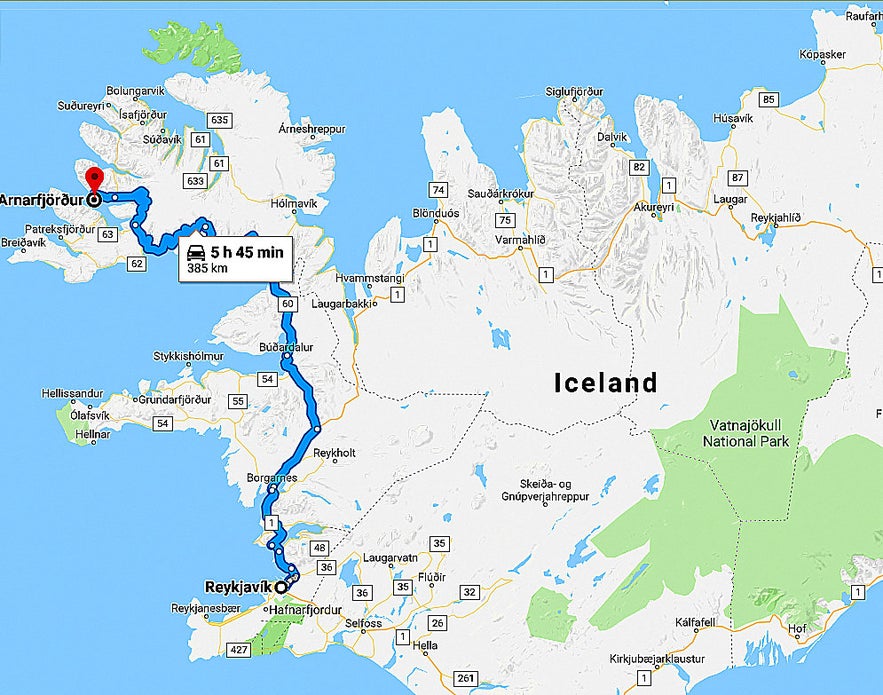
If you want to get better acquainted with the Westfjords, then I have written many travel-blogs about this interesting area of Iceland, with many more to come:
Hot pools in the Westfjords of Iceland
The majestic Dynjandi Waterfall
The Natural Wonders of the Westfjords of Iceland - Látrabjarg Bird Cliff & Rauðasandur Beach
Kjaran's Avenue - the most dangerous Road Construction in the Westfjords of Iceland
Calm Water Kayaking by Ísafjörður - the Kayaking Centre of Iceland
I am only a 1/4 Vestfirðingur (people from the Westfjords), but hope that my love for this beautiful area of Iceland shines through in my travel-blogs :)
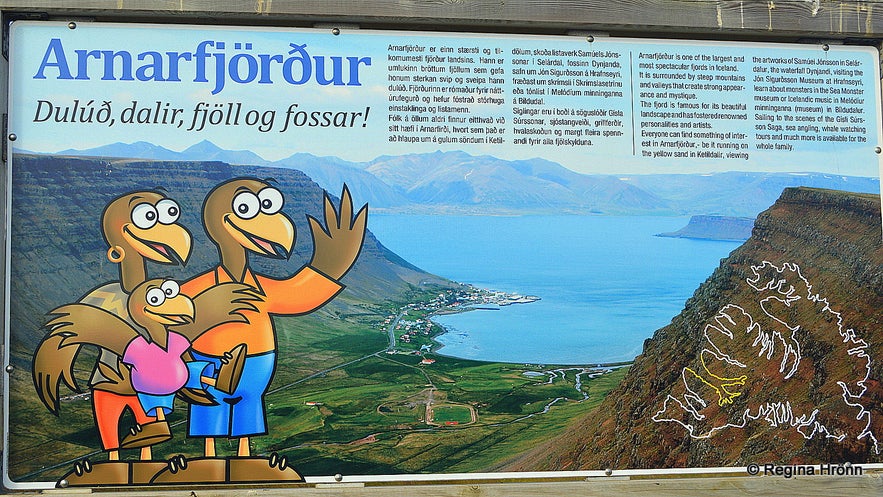
Have a lovely time in the beautiful Westfjords of Iceland :)


